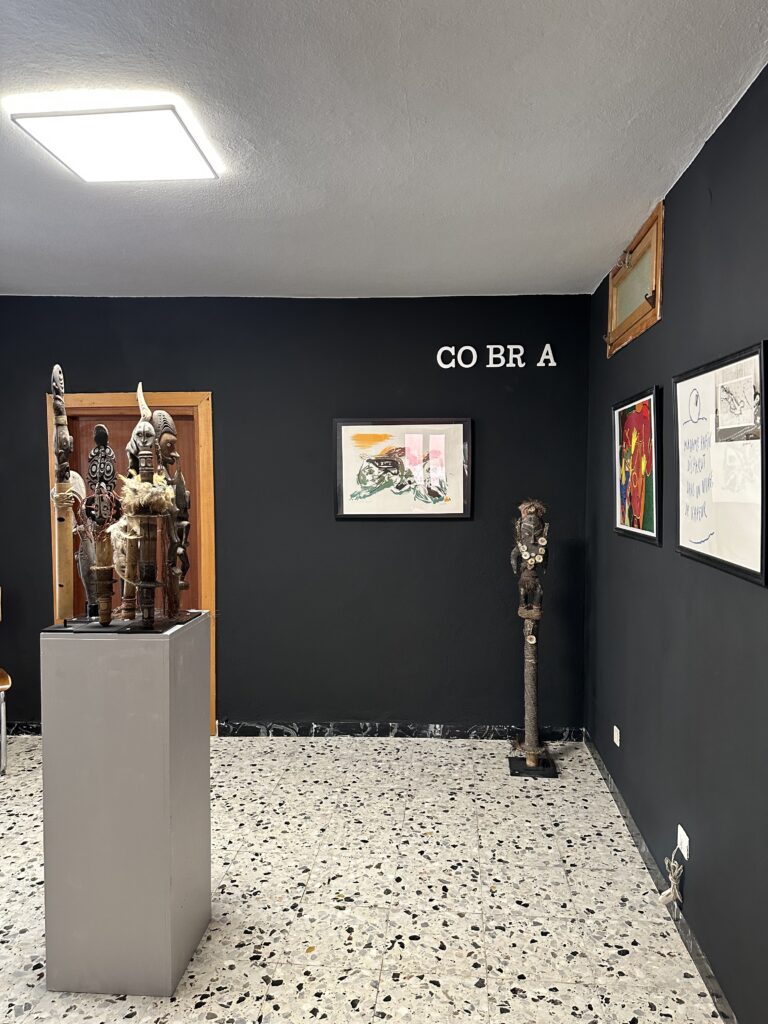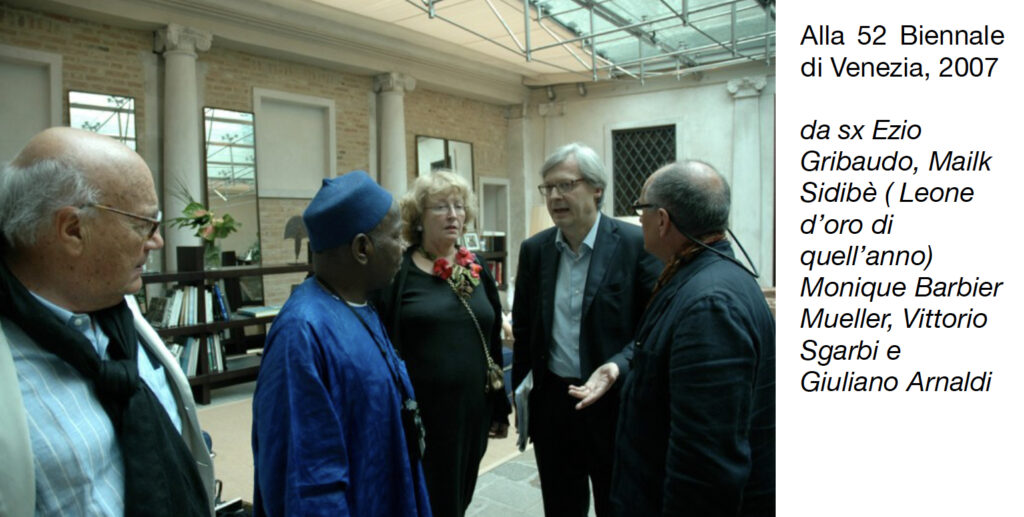Casa degli artisti, Cosio d’Arroscia.
Rete MAP MUSEO NOMADE DI ARTI PRIMARIE

In qualche modo l’esperienza dell’internazionale Situazionista, nata nel 1957 a Cosio d’Arroscia, nacque da una breve, intensa e lungimirante avventura artistica conosciuta come C0.Br.A. Il gruppo deve il nome alle città di provenienza dei fondatori, Copenaghen, Brussels, Amsterdam. Asger Jorn, Pierre Alechinsky, Karel Appel e altri tra cui Corneille e Vardercam . Nonostante la breve durata ( dal 1948 al 1951, con solo due mostre all’attivo ) quel modo di fare arte, così “brutale”, immediato e istintivo cambiò il modo stesso di intendere la pittura e la stessa idea di opera artistica. La critica radicale del mercato arrivò fino a cambiare la percezione del rapporto tra opera, artista e collezionista, e pose le basi per giungere qualche anno dopo alla provocatoria pittura industriale venduta a metro del “Situazionista” Pinot Galizio. In realtà gli Artisti del Co.Br.A. furono sperimentatori di nuove tecniche, facendo della riproduzione seriale di un’opera d’arte una esperienza non solo legata alla necessità di rendere l’accesso all’arte più economico ( e quindi più “democratico) . Le opere vennero “pensate” per essere riprodotte con tecniche di stampa particolari, spesso rese di fatto uniche con interventi originali e specifici sulle diverse copie, e gli stampatori vennero coinvolti nella creazione artistica. E’ particolarmente significativa in questa ottica l’esperienza dei Fratelli Pozzo di Torino e delle loro Edizioni d’Arte, dirette non a caso da Ezio Gribaudo, Artista poi divenuto Presidente Emerito della Accademia Albertina di Torino. La Prova d’Artista di Asger Jorn del 1970, che esponiamo in questa occasione, proviene da questa esperienza. Anche le altre opere in esposizione. La Prova d’Artista di Karel Appel , iconica nel linguaggio estetico di quel movimento, è stampata su pergamena, mentre la Prova d’Artista di Pierre Alechinsky è realizzata con tecniche diverse, dall’incisione alla fotografia. Certamente ci furono anche Artisti che della serialità dell’opera d’arte fecero un uso più “estetico” e conseguentemente commerciale, come testimonia la litografia di Corneille, ancorché realizzata in una bassa tiratura.
L’opera di Serve Vandercam è invece un dipinto su carta riportato su tela

“ Asger Jorn: dipingere con la tipografia” La testimonianza di Ezio Gribaudo “ Ho conosciuto Asger Jorn nei primi anni sessanta, durante la preparazione di un volume che ho stampato alla Fratelli Pozzo per Noel Arnaud, La langue verte et la cuite, edito da Jean-Jacques Pauvert. Il libro fu costruito sui tavoli del montaggio, dove si decorarono le lingue, si scelsero e ritagliarono le immagini; non fu preparata una vera e propria maquette, ma si procedette n una mise en page a più mani. Jorn lavorò una settimana. Fino a sera inoltrata dormendo su un lettino di fortuna in infermeria; capiva di avere a disposizione un parco macchine speciale e mi fu sempre grato di avergli dato l’opportunità di dipingere con la tipografia Jorn amava molto la tipografia, l’odore degli inchiostri e dei piombi, dei cliche e dei fani; gli piaceva lavorare direttamente sulle lastre e si cimentava a realizzare opere sperimentali di grafica di grande formato su cui interveniva personalmente di inchiostri e caratteri tipografici. Proprio per la Fratelli Pozzo realizzò la litografia più grande della sua carriera (200 x 140 cm). Jorn amava la parte più creativa e, come se si fosse trovato nel proprio atelier, riuscivamo a dar vita a un lavoro collettivo con i cromisti e le altre maestranze. Ho realizzato con lui due volumi, il primo nel 1970, Jorn a Cuba, testimonianza del suo lavoro svolto a L’Avana su invito del governo cubano nel 1968 che risponde, da un lato, all’idea dell’impegno sociale dell’autore e, dall’altro, ai legami internazionali anche con altri artisti, per esempio Wifredo Lam. Il secondo, Le jardin d’Albisola, è uscito postumo nel 1974 e documenta le ceramiche che l‘artista danese realizzava appunto in questo luogo della Liguria, ora diventato Museo.” Testimonianza di Ezio Gribaudo. Si ringrazia la dott.ssa CATERINA FOSSATI
Somehow the experience of the Situationist international, born in 1957 in Cosio d’Arroscia, was born from a short, intense and farsighted artistic adventure known as C0.Br.A. The group owes its name to the cities of origin of the founders, Copenhagen, Brussels, Amsterdam. Asger Jorn, Pierre Alechinsky, Karel Appel and others including Corneille and Serge Vardercam. Despite the short duration (from 1948 to 1951, with only two active exhibitions) that way of making art, so “brutal”, immediate and instinctive changed the very way of understanding painting and the same idea of artistic work. The radical critique of the market went so far as to change the perception of the relationship between work, artist and collector, and laid the foundations for arriving a few years later at the provocative industrial painting sold by the meter of the “Situationist” Pinot Galizio. Actually the Artists of the Co.Br.A. they were experimenters of new techniques, making the serial reproduction of a work of art an experience not only linked to the need to make access to art cheaper (and therefore more “democratic”). The works were “designed” to be reproduced with particular printing techniques, often made in fact unique with original and specific interventions on the various copies, and the printers were involved in the artistic creation. In this perspective, the experience of the Pozzo Brothers of Turin and their Art Editions is particularly significant, directed not by chance by Ezio Gribaudo, an artist who later became President Emeritus of the Accademia Albertina in Turin. Asger Jorn’s Proof of Artist from 1970, which we are exhibiting on this occasion, comes from this experience. Also the other works on display. Karel Appel’s Artist’s Proof, iconic in the aesthetic language of that movement, is printed on parchment, while Pierre Alechinsky’s Artist’s Proof is made with different techniques, from etching to photography. Certainly there were also artists who made a more “aesthetic” and consequently commercial use of the seriality of the work of art, as evidenced by Corneille’s lithograph, albeit made in a small edition.
“ Asger Jorn: painting with typography”
The testimony of Ezio Gribaudo
“ I met Asger Jorn in the early sixties, during the preparation of a volume that I printed at Fratelli Pozzo for Noel Arnaud, La langue verte et la cuite, edited by Jean-Jacques Pauvert. The book was built on the editing tables, where the languages were decorated, the images were chosen and cut out; a real maquette was not prepared, but a multi-handed mise en page proceeded. Jorn worked for a week. Until late in the evening sleeping on a makeshift cot in the infirmary; he understood that he had a special fleet of machines at his disposal and he was always grateful to me for having given him the opportunity to paint with typography. Jorn was very fond of typography, the smell of inks and leads, clichés and fans; he liked to work directly on the plates and tried his hand at creating experimental works of large format graphics on which he personally intervened with inks and typographic characters. Precisely for Fratelli Pozzo he created the largest lithograph of his career (200 x 140 cm). Jorn loved the most creative part and, as if he were in his own atelier, we were able to create a collective work with the chromatists and other workers. I wrote two volumes with him, the first in 1970, Jorn in Cuba, evidence of his work carried out in Havana at the invitation of the Cuban government in 1968 which responds, on the one hand, to the idea of the author’s social commitment and , on the other hand, to international ties also with other artists, for example Wifredo Lam. The second, Le jardin d’Albisola, was published posthumously in 1974 and documents the ceramics that the Danish artist made precisely in this place in Liguria, which has now become a museum.”
Testimony of Ezio Gribaudo.
Thanks to Dr. CATERINA FOSSATI